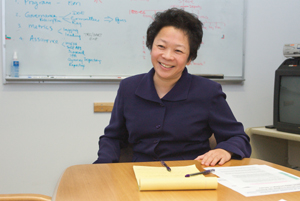
Spectroscopy
for the Real World
Year of BLIS Takes
Shape at Berkeley Lab
Spectroscopy for the Real World
Amid the Advanced Light Source’s beamlines, workstations, and hardware is a first-of-its-kind photoelectron spectroscopy system designed to give scientists a ringside seat to everyday phenomena.
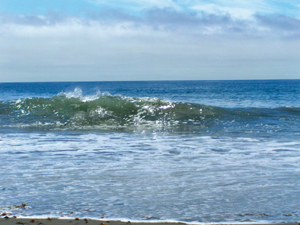
Crashing waves emit airborne salt particles that impact environmental
processes. A new spectroscopy system gives scientists a better understanding
of such phenomena.
It has already paved the way for a better understanding of the role played by tiny airborne salt particles, emitted into the air by crashing waves and sea spray, in a slew of atmospheric and environmental processes, such as the destruction of the ozone layer.
“This is important because many atmospheric phenomena are driven by reactions with the surface of sea-salt aerosols,” says Miquel Salmeron, a physicist with the Materials Sciences Division who has pioneered new ways of exploring the molecular behavior of liquids on surfaces. “We found that anions (negatively charged ions) concentrate at the surface of salt grains as they dissolve in water.”
The study was published in the Jan. 28, 2005 issue of Science.
The research also underscores the merits of the new spectroscopy system, recently developed by Salmeron and colleagues, which enables scientists to study the chemical underpinnings of catalytic, biological and ecological processes in their natural environment — that is, at almost normal pressures and in the presence of water vapor.
The ALS is one of only two places in the world where photoelectron spectroscopy can be performed on surfaces at pressures above 1 torr (a unit of pressure equivalent to 1 millimeter of mercury in a barometer). The only other such instrument is at a synchrotron in Berlin, Germany, which follows Salmeron’s design. All other photoelectron spectroscopy systems require a dry, high-vacuum environment.
“But a lot of information is lost once a compound is placed in a vacuum, so we developed an instrument to circumvent this problem. In order to understand real-world chemical processes, we need to analyze them as they occur in the real world,” says Salmeron, who collaborated with John Hemminger of UC Irvine on the salt-solution study. UC Irvine’s Sutapa Ghosal, and Berkeley Lab’s Hendrik Bluhm, Eleonore Heben-streit, Guido Ketteler, Bongjin Simon Mun, Frank Ogletree, and Felix Requejo also contributed to the research.
Scientists have had to rely on theory and indirect observations to explain how anions in salt grains rearrange themselves when the salt liquefies after absorbing water vapor from the surrounding air. Molecular dynamic simulations indicate that the anions migrate and become enriched at the droplet’s surface. Other techniques allow scientists to observe the indirect, telltale signs of this change. But until recently, there was no way of directly observing and quantifying this phenomenon.
Enter the high-pressure photoelectron spectroscopy system, a second-generation instrument that began operating at one of the ALS’s beamlines (11.0.2) last year. (A first-generation system was developed in 2000). Like all photoelectron spectroscopy systems, it identifies elements by detecting their unique spectral signals. But unlike others, it can do this under pressures and humidities similar to those faced by everyday phenomena. The system has already elucidated the century-old puzzle of how a liquid-like film exists on the surface of ice close to its melting point. It has also shed light on how the rhodium metal surface adsorbs and removes carbon monoxide and nitrogen oxide gases in car exhaust converters.
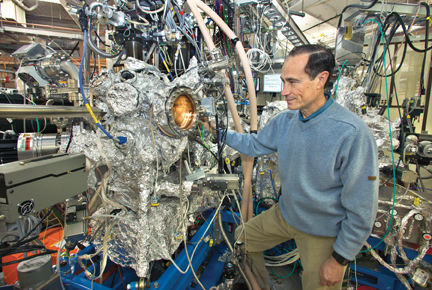
Miquel Salmeron is pictured at ALS beamline 11.0.2, site of the high-pressure
photoelectron sprectroscopy system.
Buoyed by this success, the team trained the instrument on the secret lives of sea-salt aerosols. Conventional spectroscopy experiments have revealed that there are just as many negative ions as positive ions on the surface of a dry salt grain. To determine what happens in the presence of water, they placed salt grains composed of potassium bromide and potassium iodide in the high-pressure spectroscopy system’s vacuum chamber and slowly increased the humidity. A thin film of water develops on the grains, and when the vapor pressure is high enough, the grains liquefy. For the first time, the instrument enabled the team to spectroscopically chronicle the ions’ behavior, from the moment water condenses on the grains’ surfaces until after the grains dissolve. They found that positively charged potassium ions sink a few atomic layers, while the negatively charged iodine and bromine ions rise to the surface.
“This is the first direct observation. Other techniques reveal the indirect events related to enhanced surface ions, but we show it,” says Salmeron. “Because spectroscopy doesn’t lie, with our technique, there is no possibility for misinterpretation.”
Their results matched molecular dynamic simulations of the phenomenon, but not perfectly. The team determined that more anions congregate on the surface than the theories predicted, meaning the theories require further refinement. That’s not too surprising, given that the quantitative knowledge of how surfaces of materials interact with water is in its infancy.
“Even in 2005, in this high-tech era, no one can tell you how much water is on a piece of glass in a humid room,” says Salmeron. “And surface interactions with water are of fundamental importance to many catalytic, geological, physical, and biochemical processes. Our hope is this tool will give researchers a comprehensive view of these phenomena.”
In the near future, for example, Salmeron and his team hope to analyze how other gases that play a role in ozone destruction, such as chlorofluorocarbons, change in the presence of water. They’ll also examine how humidity affects the surface of silicon, which is used to make microchips and other electronic devices.
Year of BLIS Takes Shape at Berkeley Lab
Thanks to the combined efforts of the Information Technologies and Services Division (ITSD) and Operations, 2005 will be the year of BLIS at Berkeley Lab — at least in terms of information exchange and data access, that is.
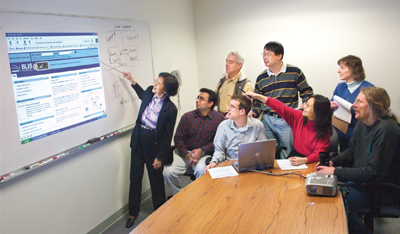
ISS Head Diana Brown (left) discusses elements of the new BLIS portal
with the development staff (standing from left) Thanasis Bothos, Sam
Li, Carole Casaretto, and (seated from left) project manager Vik Bhatia,
Dale Federighi, Vickie Ng, and Rob Macfarlane.
BLIS stands for Berkeley Lab Information Systems, which will make Lab life more streamlined, more efficient, more productive, and hopefully more, well, blissful. The web portal will integrate a number of systems providing data from such sources as budget, accounting, procurement, travel, human resources, payroll, workforce management, property management, and safety and security. And BLIS will provide something for everyone. Not only will principal investigators be able to access the latest budget information about their research, but senior management will also be able to create automatic and on-demand assurance reports regarding Lab performance.
While the Operations departments are providing the information, ITSD has developed the tools for accessing the data. For most Lab employees, the point of entry will be the BLIS portal, a customizable web page with a set of packaged links that allow users access to the most useful, essential and desirable websites, programs, applications, and reference materials needed to do their jobs. For instance, one section provides directory links to the DOE, to other national labs and to all UC campuses.
Lab management is so confident of its utility that BLIS is being built in as the default home page with the Mozilla browser for all new computers registered at the Lab. Under development for two years, BLIS is being formally rolled out in FY2005.
“We wanted to create an information ‘cockpit’ for customers to easily navigate in and get integrated information, resources and services,” said Diana Brown, the head of the Information Systems and Services Department who has been developing the BLIS vision since she arrived from UC Berkeley in 2002, where she was the campus director of Administrative Systems. “We needed to put together both a portal (gateway) and a suite of decision support systems consisting of an enterprise data warehouse and various reporting options, catering to the diverse needs of the user community.”
Enter BLIS. One screen’s worth of links includes one-click admission to Lab news sites, important announcements, lab policies, interactive applications like LETS-lite (the Lab’s latest electronic timekeeping system) and Employee Self-Service, and important Lab documents.
The site can also be customized to select and add content blocks, choose color themes, and rearrange the portal content. And it’s all within the protection of the LDAP password, so that the user alone controls the access to his or her portal. It’s one-stop shopping to provide easy access to required and desired resources.
Although Berkeley Lab doesn’t have a traditional intranet, BLIS is the next best thing. External visitors to the Lab home page will be able to navigate to the BLIS home page, but that’s as far as they can go. The customized pages are only accessible to users with log-in ID and password. That’s important to preserve individual privacy and makes it convenient to access from anywhere outside the Lab.
Upon attending BLIS training, users are automatically granted subscription privilege to the BLIS Decision Support Systems.
“We want to make information available with only a few simple keystrokes so that management can make informed decisions,” she said. “The goal is for this project to be driven by the customers. Division directors should be able to know which projects are running on time and which are spending too much. They should know which programs are spending more on labor and which ones on training or on hardware. Budget analysts should be able to create reports on their own. Now that the potential and possibilities of the project have been demonstrated, we would like customers to tell us what they want and in which priority order. BLIS will evolve to deliver the desired functionality.”
The BLIS portal is being largely developed by software engineer Dale Federighi. Charles Howard is the data architect for the enterprise data warehouse. Loading of the warehouse with transactional systems data is accomplished by Extract Transform and Load (ETL) specialists Rob Macfarlane and Sam Li. Business Intelligence Tools expert Vickie Ng, with limited consulting assistance, is responsible for the report offerings. BLIS infrastructure maintenance and database administration require constant attention and support, supplied by Dennis Baker, Tony Lincoln, Dan Klinedinst, and Thanasis Bothos. Vik Bhatia is the project manager.
Brown said the Berkeley Lab portal is unusual in that it utilizes open-source rather than proprietary software, which saves the Lab more than a million dollars. One reason is the multiplatform customer base that’s found here — PCs, Macs, UNIX and LINUX. The software uPortal is primarily used by higher education institutions like Yale and Columbia and seemed like a natural fit at Berkeley Lab. Also incorporated is Cognos, a suite of business intelligence tools that allows the building of predefined queries, ad hoc queries, standard reports, online multidimensional analysis templates, and various executive “dashboard” reports with drill-down capability from summaries to details.
The BLIS portal opens up to a main tab screen that houses content blocks called channels. A channel is a group of web links, application widgets, and system interfaces that provide access to information on various topics. Users can select and organize the channels to meet their needs. “Single sign-on” has been implemented to take you directly (without another stop for an LDAP name or password) to applications like LETS-lite, the Job Hazards Questionnaire, and ergonomic evaluations. More single sign-on to the so-called “lifeline” applications — such as e-mail, calendar, employee self-service, and e-procurement — will be added over time, Brown said.
Other convenient features include a comprehensive set of links to phone directories for name searches, a channel for an unlimited number of bookmarks (sorted either by name or by creation date), an announcement box for important messages and reminders (updated daily, or hourly if needed), and a keyword search tool linked to Google, Yahoo, Altavista and Lab sites.
Shuttle bus schedules, benefits information, and Lab news and publications can all be accessed directly from the BLIS portal.
To take a test drive, click on the BLIS link from the main Lab website index under “B”, and insert your LDAP name and password at the top of the public BLIS portal. That will take you to your personal BLIS page, which can be converted to your log-on home page using the link myblis.lbl.gov. Take the self-study tutorial and read the Frequently Asked Questions (FAQs) on the portal itself.
Twice-a-month two-hour classes are offered (see sidebar) on using the decision support system of BLIS. You may sign up for training at hris@lbl.gov. For questions or comments about BLIS, click on the “feedback” link on the upper right of the BLIS portal.
BLIS Classes
The basics of BLIS —
Decision Support System
- Channels and channel controls
- Preferences: manage channels, tabs or color schemes
- Delivered/default channels
10 a.m–noon
February 23 March 14
April 19 May 25
June 22
BLIS Query
- Hands-on access to query, query navigation, using tables to build custom queries
- Introduction to reports
- User resources
1:30–3:30 p.m.
February 23 March 14
April 19 May 25
June 22
High Schoolers Match Wits at Science Bowl
What astronomical phenomenon did Rudolph Wolf count by adding 10 times the number of groups of them he saw to the number of single ones he saw? If you answered “sunspots,” then you may have been able to compete with the 80 students who descended upon the Lab last Saturday to match wits in a regional science bowl.
Twelve local schools and 18 teams (some schools sponsored more than one team) showed up for the event. Using a double elimination system, teams worked their way through the daylong competition. Harker High’s Team One came out on top, with Homestead second.
More than 35 volunteers helped out with the science bowl, many of them Lab employees. They served as moderators (the person who reads the questions), timekeepers (each team got five seconds to answer a toss-up question and 20 for a bonus question), and scorekeepers (four points for a toss-up and 10 for bonus). Students were treated to breakfast, lunch, and tours of the Advanced Light Source during their visit to the Lab.
Harker’s team will travel to Washington, D.C. later this spring, all expenses paid, to compete in the national science bowl sponsored by the Department of Energy. Prizes include money for schools, trophies, calculators, PDAs and trips.
Saturday’s event was organized by the Lab’s Center for Science and Engineering Education.
— Lyn Hunter
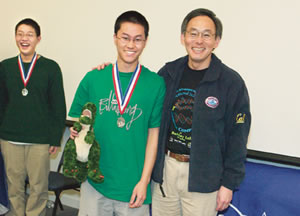
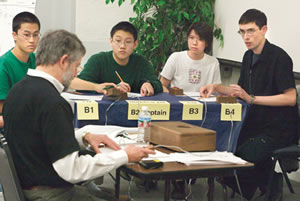
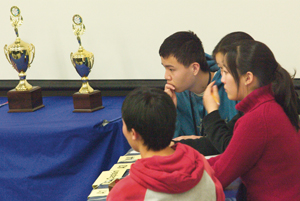
The competition was intense during last Saturday's Science Bowl. On
the left is the winning team from Harker High School in San Jose,
with their competitors from Albany High concentrating intently. Top:
Lab Director Steve Chu with one of a proud member of the winning team.
At ‘Chez Hanny,’ Home is Where the Jazz Is
Frank Hanny, a programmer with Information Technologies and Services Division, is a huge jazz fan. But the dwindling number of venues in the Bay Area makes it difficult for him to hear live music. And the few places that still feature jazz leave much to be desired, he says.
“I frequently have to strain to hear the artists over the din of talking and laughter,” says Hanny, who’s worked at the Lab for 10 years. “The music seems almost secondary.”
While the annual San Francisco Jazz Festival offers concerts for the more serious listener, the venues are so large, it is hard to get close enough to see the performers.
But Hanny’s found a way to ease his frustration: producing concerts in his own home.
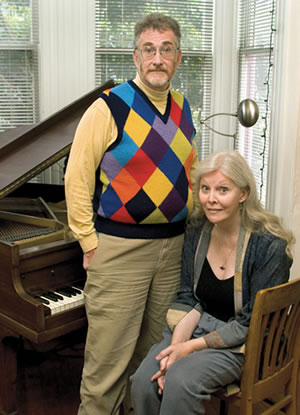
Frank Hanny is pictured at his home in San Francisco with pianist
Jessica Williams.
The idea came to him on his 50th birthday in 2000. To help celebrate his half-century of life, he decided to throw a party in his home and hired critically acclaimed pianist Jessica Williams to perform.
“I made contact through her website and was so excited when she agreed to play,” recalls Hanny. “The event was such a success, some musicians in attendance asked if they could perform at my home too.”
Not long after, Hanny began hosting monthly Sunday afternoon concerts, featuring such performers as Larry Schneider, Paul McCandless, Dick Hindman, John Stowell, Mark Levine, and Kendra Shank.
“I live in an old Victorian flat in San Francisco that is ideally suited for concerts,” he explains. “The performers set up in front of a bay window, which faces a large room in which we can fit about 30 to 35 folding chairs. And the acoustics are excellent.”
Thanks to word of mouth and Hanny’s website (http://home.earthlink.net/ ~fchanny/jazz.html), his house concerts have become quite popular. In fact, artists from across the country are now sending him CDs hoping he’ll book them.
“I try to diversify the lineup,” says Hanny of his booking philosophy. “I mix established artists with those who are up and coming, and musical styles, from vocals and progressive to swing.”
Those who attend the concerts are asked to donate $20 to $25 and to bring a dish and beverage to share. In return, they not only get to hear top-notch music, but can also mingle with the artists and other fans.
It’s a treat for the performers as well, says Hanny. “The
money may not be the greatest, but they enjoy playing in such an intimate
setting for such an appreciative audience, and without having to make
commercial compromises in the music.”
San Francisco District Attorney Kamala Harris to Speak at Lab
San Francisco District Attorney Kamala D. Harris, the first woman ever elected to this position in San Francisco, will speak at Berkeley Lab on February 14 in honor of Black History Month. Her talk on civil rights will be held at noon in the Building 50 auditorium.
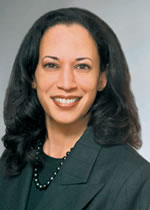
Harris
Elected D.A. in December 2003, Harris was born in Oakland and raised in Berkeley. Her parents, both professors, were active in the civil rights movement and instilled in Harris a strong commitment to justice and public service. That commitment led Harris to study at Howard University, America’s oldest black university, and then at Hastings College of Law. Harris’ mother, Shyamala Harris, is a breast cancer expert at Berkeley Lab.
Since taking office, Kamala Harris has focused on implementing a “smart on crime” approach in the city — prosecuting crime with resolve while maintaining a commitment to rehabilitation and the preservation of civil liberties. She has reduced the backlog of homicide cases, expanded protection for witnesses of violent crime, implemented tough new gun charging policies, expanded Community Courts, and brought free legal clinics to immigrant neighborhoods.
Of special interest to Harris throughout her career has been the protection of women and children. As D.A. she has taken a leadership role locally and statewide to promote programs and legislation in these areas. For instance, her work to defend exploited children resulted in successful state legislation that will create increased punishment for those who sexually exploit youth.
Harris has mixed ethnic heritage — Indian on her mother’s side and Caribbean African American on her father’s. Her sister Maya Lakshmi is also an attorney.
A deputy district attorney in Ala-meda County from 1990 to 1998, Harris has been a longtime community activist in the Bay Area. She served as co-chair of the Lawyers’ Committee for Civil Rights, president of the Board of Directors of Partners Ending Domestic Abuse, founder of the Coalition to End the Exploitation of Kids, and founder of a mentoring program at the San Francisco Museum of Modern Art that has served hundreds of young people from the inner city.
Harris’ distinguished career has been recognized repeatedly. She was honored as “First Woman in the Law” by the Historical Society of the U.S. District Court for the Northern District of California; as “Child Advocate of the Year” by the San Francisco Child Abuse Prevention Council; as a “Woman of Power” at the 2004 National Urban League Conference; and she was honored by the County Counsel Association of California for her work granting gay couples equal rights in child adoption cases.
New DOE Secretary Takes Over
Samuel Bodman was sworn in Tuesday as the 11th Secretary of the U.S. Department of Energy at a private ceremony, one day after being unanimously confirmed by the Senate. In assuming the reins of a department with a budget in excess of $23 billion and more than 100,000 federal and contractor employees, he succeeds Spencer Abraham, who resigned from the position in November.
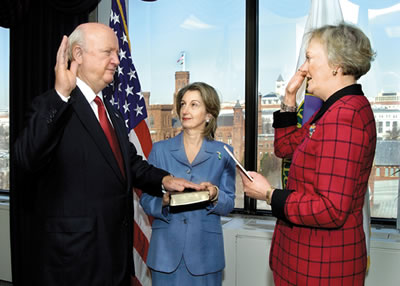
Samuel Bodman, shown here with his wife Diane (middle), was sworn
in by Susan Grant (right), director of DOE's Office of Management,
Budget and Evaluation as Secretary of the U.S. Department of Energy
at a private ceremony on February 1.
Bodman, 65, who held two appointments in President George W. Bush’s first term — first as deputy secretary of the Department of Commerce and then as deputy secretary of the Treasury — is a former professor of chemical engineering at the Massachusetts Institute of Technology. He has spent the past three decades working in the private sector as a financier and executive. Bodman will be sworn into office again in a later public ceremony.
“It is a great honor and personal privilege to serve President Bush and the American people as secretary of Energy,” Bodeman said. “I look forward to working with the fine men and women of the Energy Department to advance this department’s critically important missions, including preserving America’s pre-eminence in the physical sciences, ensuring the responsible stewardship of our nation’s nuclear weapons stockpile, advancing our international nuclear nonproliferation efforts, and ensuring reliable, secure, affordable and environmentally responsible supplies of energy for our growing economy.”
When he nominated Bodman for the position, President Bush said, “In academics, in business, and in government, Sam Bodman has shown himself to be a problem solver who knows how to set goals, and he knows how to reach them. He will bring to the Department of Energy a great talent for management and the precise thinking of an engineer.”
Bodman was born in 1938 in Chicago. He earned a B.S. in chemical engineering from Cornell University in 1961. Four years later, in 1965, he completed his Sc.D. at MIT, where he would remain as a professor until 1971. Leaving academia, he joined the private sector as technical director of the American Research and Development Corporation, a pioneer venture capital firm. He and his colleagues provided financial and managerial support to new business enterprises throughout the United States. In 1983 he was named president and CEO of Fidelity Investments and a director of the Fidelity Group of Mutual Funds. In 1987 he joined Cabot Corporation, a Boston-based Fortune 500 company with global business activities in specialty chemicals and materials, where he served as chairman, CEO, and director.
Over the years, Secretary Bodman has also been active in public service. In addition to extensive volunteer work for MIT, he has served as a member of the American Academy of Arts and Sciences and as a trustee of the Isabella Stewart Gardner Museum and the New England Aquarium. He is married to M. Diane Bodman and has three children, two stepchildren, and eight grandchildren.
Key Mechanism in Genetic Inheritance Identified
A key mechanism in the passing of genetic material from a parent cell to daughter cells appears to have been identified by a team of Berkeley researchers. Their study may explain how a complex of proteins, called kinetochores, can recognize and stay attached to microtubules, hollow fibers in the walls of biological cells that are responsible for the faithful segregation of chromosomes during cell division.
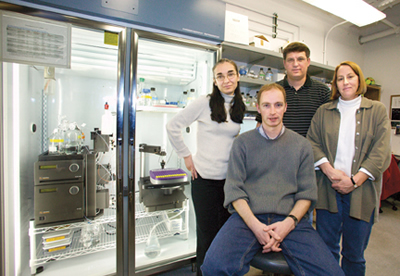
From left: Eva Nogales, Stefan Westermann, David Drubin, and Georjana
Barnes, scientists with Berkeley Lab and UC Berkeley, have identified
a key mechanism in the passing of genetic material from a parent cell
to daughter cells.
“In test tube experiments, we’ve found that the kinetochore proteins form rings around the microtubules, and this ring formation promotes microtubule assembly, stabilizes against disassembly, and promotes bundling,” says Eva Nogales, a biophysicist who holds joint appointments with Berkeley Lab, UC Berkeley and the Howard Hughes Medical Institute. “If ring formation takes place in vivo, it could be the mechanism by which chromosomes are kept segregated during mitosis.”
Nogales is one of the co-authors of a paper reporting the results of this research, which appears in the Jan. 21, 2005 issue of the journal Molecular Cell. Other authors of the paper are Georjana Barnes, David Drubin and Stefan Westermann with UC Berkeley’s Department of Molecular and Cell Biology, who were the lead investigators on this work, plus Agustin Avila-Sakar and Hong-Wei Wang with Berkeley Lab, and Hanspeter Niederstrasser and Jonathan Wong with UC Berkeley.
Says Barnes, “Mistakes in chromosome segregation during mitosis contribute to cancer and birth defects. From various genetic experiments we know that the activity of a 10-protein complex of kinetochores, called Dam1, is responsible for the faithful segregation of chromosomes during mitosis. While we don’t know at this time that ring formation occurs in vivo, we do see in our in vitro tests that Dam1 ring formation strengthens the microtubules.”
Thousands of microtubule fibers are woven together to form a highly flexible cytoskeleton in biological cells that gives shape to cell walls and other structures and controls the transportation of substances in and out of a cell. During cell division (mitosis), the microtubule fibers disassemble and reform into spindles across which duplicate sets of chromosomes line up. During this phase, it is critical that the spindles maintain their structural integrity so that they can segregate a single copy of each chromosome to each daughter cell. Thereafter, the microtubules again disassemble and reform back into skeletal systems for the two new daughter cells. It has been determined through the genetic research of Barnes and Drubin, among others, that kinetochores must bind to a microtubule spindle to avoid the gain or loss of chromosomes by each of the daughter cells. How this works, however, was unknown.
To find answers, the Berkeley researchers used a purified, reconstituted Dam1 complex, obtained from genetically engineered E. coli bacteria, and compared its effects on microtubules in vitro to the effects caused by certain Dam1 mutants. Their analysis shed new light on the structural nature of the kinetochore-microtubule interface, and may provide a biochemical explanation for the role of kinetochores in maintaining chromosome segregation during mitosis.
“Our studies indicate that the Dam1 rings are formed by longitudinal self-assembly of multiple copies of the Dam1 complex upon the microtubule surface,” the authors state in the Molecular Cell paper. “Although the presence of microtubules strongly facilitates the oligomerization process, ring assembly seems to be an intrinsic property of the Dam1 complex, as we have been able to induce self-assembly into rings in the absence of microtubules.”
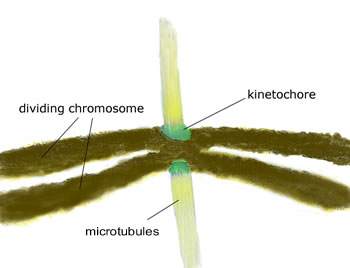
Kinetochore proteins bind to a microtubule spindle to keep chromosomes
segregated during cell division. This segregation is critical for
preventing mistakes that can lead to cancer and birth defects.
The formation of rings around the microtubules by the purified Dam1 complex that the Berkeley collaborators observed has not been reported for any other microtubule binding protein complex. While the authors say that ring formation is a complicated way to construct a microtubule binding structure, a microtubule binding ring might be uniquely suited to fulfill the functions of the Dam1 complex. In comparison with the purified Dam1, the Dam1 mutants produced partially formed rings that reduced microtubule binding.
“Because the stability of a microtubule is thought to be largely governed by the lateral interactions between adjacent protofilaments,” the authors note, “rings that bind orthogonally to the microtubule axis are not only expected to strengthen interprotofilament interactions, but to also prevent protofilament peeling, which in turn would encourage further growth.”
Furthermore, the Berkeley researchers showed that binding between the ring and the microtubule is mediated by flexible domains, and is largely electrostatic in nature.
This could allow for lateral sliding or diffusion of Dam1 rings along microtubules. Analysis of the Dam1 rings after disassembly of microtubules revealed an accumulation of rings at the ends of the microtubule, suggesting that the rings do not disassemble but slide back as the microtubule protofilaments peel away from the ends.
Says Nogales, “That the rings remain attached to the microtubule end, as it depolymerizes, is a most ingenious mechanism to move the chromosome to the two daughter cells during anaphase without even requiring energy. This is a great finding!”
Catching up with the Lab’s Safety Chief
Skydiving and bungee jumping aren’t usually associated with safety, but Phyllis Pei, director of Berkeley Lab’s Environment, Health & Safety Division since August, doesn’t shy away from challenges.
“I didn’t want to just be a spectator, so I decided to participate,” said Pei, recalling her adventurous leaps a few years ago.
Her career is marked by a similar pursuit of challenges. She grew up in Shanghai and Hong Kong and came to the U.S. in the 1970s to pursue a college and graduate education. She received a bachelor’s degree in chemistry and masters degrees in biochemistry and business administration from schools in Texas. Since then, she has gained extensive leadership experience in EH&S programs in private industry, consortia and national laboratories.
Pei comes to the Lab from Applied Materials in Santa Clara, where she was the senior director of the company’s worldwide EH&S program.
VIEW: How did you get in involved the EH&S field?
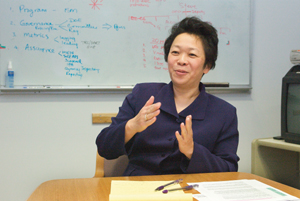
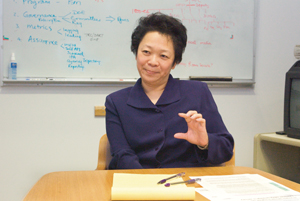
PeiPEI: After obtaining my graduate degrees, I started with a chemical procurement job at a semiconductor manufacturing company in Texas. Part of the job included chemical disposal using tanker trucks. One of the tanker companies presented us with a bill stating that we gave them waste that ate up their tanker. So I had to stop doing business with them, while at the same find alternative ways to manage the chemical waste from our production processes. That was the beginning of my career in environmental affairs.
My next job was a cradle-to-grave chemical management position. Someone working at a peer organization was badly injured in an acid spill. That incident, along with my biochemistry degree, got me interested in safety, toxicity, and the health effects of the workplace. So my career naturally evolved into the EH&S field.
VIEW: Are there any lessons you’ve learned from working in the private sector that can help you perform this job?
PEI: I can apply some of the business processes that we have used in the private sector, such as change management, project management, and process efficiencies. I’ve also worked in government agencies, private companies, nonprofit consortiums, and internationally, so I’ve been exposed to a range of different business approaches and ethnic cultures.
VIEW: How has the transition from Applied Materials to Berkeley Lab been so far?
PEI: I have been busy getting up to speed, hiring two people on my staff, and am involved in the preparation of the Lab’s management contract proposal, in which safety is a key component. The people here have been very welcoming and the highly capable EH&S staff are exceptional people to work with.
VIEW: As a senior manager who is a woman, do you envision more females holding leadership positions in the future?
PEI: There are plenty of other talented and capable women out there, and it is just a matter of time before they are given the opportunity to lead. There is no limit for more women to assume higher ranks in the future. I look forward to having more of them as my peers. I am willing to help the Lab develop more women executives.
VIEW: In FY 2004, Berkeley Lab posted the best safety record of the 10 Office of Science labs, reducing by more than 50 percent its injury rate. What is this reduction attributed to? What’s next?
PEI: I believe the key is management commitment and safety awareness throughout the organization. One of the reasons that I chose to work here is that both Charles Shank and, now, Steven Chu and the division directors are highly committed to safety.
We are looking at several initiatives for the future. One is a formal recognition program for positive safety behavior. We want to constantly promote safety awareness. Director Chu has also started townhall meetings, and I have spoken at several of them. We are also going to implement a comprehensive safety awareness program that will ensure that we keep employees’ safety awareness up in a more formalized way throughout their careers here. We are also raising the bar on safety performance scorecards. Last year we expected people to receive training in ergonomics, and this year we are requiring more than 90 percent of staff to complete ergo (EHS060) for each division.
VIEW: You have been seeking customer feedback on how to improve EH&S programs. What kind of feedback have you been getting?
PEI: People want better safety coaching and user handholding. This means greater EH&S presence in the field. They also want improved safety programs, such as laser and ergonomic safety. We have a started a laser safety initiative in which our laser safety officer will observe laser alignments. He will conduct on-the-job training and guide people in how to do things more safely. We want to provide more tools for supervisors, safety coordinators, and liaisons to do their jobs effectively.
Our workstation ergonomic injuries are keeping pace with the overall injury reduction. But the material handling injuries, caused by lifting, aren’t dropping by as much as we’d like. We want to find other ways to prevent injuries, such as conduct benchmarking of material handling companies like UPS.
VIEW: What initiatives are occurring on the environmental side?
PEI: We’ve included in the division scorecard elements such as environmental violations from agency inspections and waste descriptions compliant with quality control. Also, the majority of our regulatory inspection violations have come from people putting inappropriate materials — such as acids, oils, batteries — into salvage or reclaim dumpsters, so we are working with Facilities to design a better dumpster/hopper management program.
VIEW: What are some of the challenges facing Berkeley Lab?
PEI: Because of all of the incidents throughout DOE labs, I believe that people at this lab may be afraid to report incidents or go to health services after an accident. They may be afraid they will be punished or they will shut down the entire Lab. People need to adhere to what they have been trained to do and not take shortcuts. We understand mistakes do happen and we want to learn from them. But we will not tolerate violation of safety rules and procedures. Even near misses need to be reported so we don’t deprive the rest of the Lab from learning how to avoid accidents. I have asked the safety review committee and safety liaisons to develop recommendations on how to allay the fear of reporting.
We also have a task force on business resumption. If we had an incident that shut down the Lab, then we should have a plan, approved by the Berkeley Site Office, which would allow us to resume work in nonaffected areas as soon as possible. And this is based on the assumption that bad accidents are isolated cases. We believe that the majority of people have embraced the idea of their personal ownership of safety. I’d like employees to take safety ownership a step further and look after their peers and help them work safely too.
Berkeley Lab View
Published every two weeks by the Communications Department for the employees and retirees of Berkeley Lab.
Reid Edwards, Public Affairs Department head
Ron Kolb, Communications Department head
EDITOR
Monica Friedlander, 495-2248, msfriedlander@lbl.gov
STAFF WRITERS
Lyn Hunter, 486-4698
Dan Krotz, 486-4019
Paul Preuss, 486-6249
Lynn Yarris, 486-5375
CONTRIBUTING WRITERS
Jon Bashor, 486-5849
Allan Chen, 486-4210
David Gilbert, 925-296-5643
FLEA MARKET
486-5771, fleamarket@lbl.gov
Design
Caitlin Youngquist, 486-4020
Creative Services Office
Communications Department
MS 65, One Cyclotron Road, Berkeley CA 94720
(510) 486-5771
Fax: (510) 486-6641
Berkeley Lab is managed by the University of California for the U.S. Department of Energy.
Online Version
The full text and photographs of each edition of The View, as well as the Currents archive going back to 1994, are published online on the Berkeley Lab website under “Publications” in the A-Z Index. The site allows users to do searches of past articles.
Nersc’s Hi-Res Map of Cosmic Microwave Background
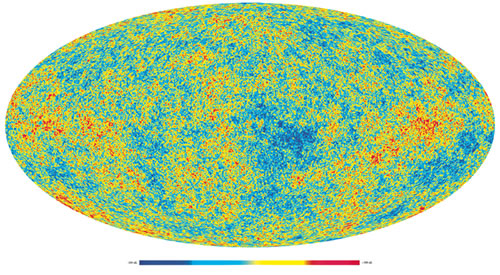
Berkeley Lab researchers, led by Julian Borrill, have used a year’s
worth of simulated data and the Seaborg supercomputer at NERSC to
produce this high-resolution Cosmic Microwave Background map. Running
6,000 of Seaborg’s processors at once, the researchers mapped
75 billion observations to 150 million pixels in just two hours. The
colors show tiny temperature fluctuations in the microwave radiation
that’s an echo of the Big Bang. Collaborating with Borrill on
this project were CRD’s Radek Stompor and Christopher Cantalupo
of UC Berkeley’s Space Sciences Laboratory, where Borrill and
Stompor also hold appointments. The collaborators give much credit
to the NERSC staff as well.
Carl Haber on ‘Imaging the Voices of the Past’
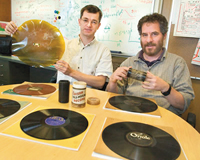
Vitaliy Fadeyev (left) and Carl Haber.
Physicist Carl Haber, who along with colleague Vitaliy Fadeyev has gained world attention for having found a way to digitize century-old recordings, will be the featured speaker at the next Friends of Science event, to be held on Wednesday, February 16 from 5:30 to 7 p.m. at the Berkeley High School Library (Allston Way at Milvia Street).
The two Berkeley Lab physicists have applied the technology used in studying subatomic particles to reviving treasured voices from the past. As a result of their ingenuity, some of the music and spoken word recordings in the Library of Congress collection may spring back to life. These methods may also help us gain access to and preserve recordings dating back to the late 19th and early 20th centuries.
Haber’s talk will include examples of restored voices and music, and will demonstrate how basic scientific research done at Berkeley Lab may yield results of benefit in other areas of science and culture.
The event, cosponsored by Berkeley Lab Friends of Science and the
Berkeley High School Science Department, is free to the public.
In Memoriam
Jack Kroll
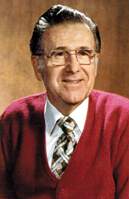
Kroll
Hired right out of high school by Ernest O. Lawrence in 1938, Jack Kroll, a shop superintendent in the Engineer-ing Division, died on Dec. 5, 2004 after a 43-year career at Berkeley Lab. He retired in 1982.
Kroll began as an apprentice machinist on campus, moved up to the Hill when the 184-Inch Cyclotron was built, and later was instrumental in the interior layout of the Building 77 mechanical shop.
In addition to his regular duties, Kroll also served as a fireman in the days when the Lab had an all-volunteer force. Kroll used to recall how one time when he didn’t receive his paycheck on time, he mentioned it to the Lab director. Lawrence wrote out a personal check to pay him.
Kroll is survived by his wife of 56 years, Florence, daughter Jill, son Tom, five grandchildren and four great-grandchildren.
Bob Hinckley
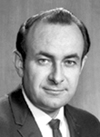
Hinkley
Robert "Bob" Hinckley, who worked at the Lab for more than three decades, passed away on January 17. He was 74 years old.
Hinkley came to the Lab in 1960 and served in different capacities,
including business manager of the Physics Division and later worked
in the Engineering Division. He retired in 1990. A memorial service
was held in Oakland.
Flea Market
- HOUSING
- ALBANY, spacious 1 bdrm inlaw unit on hill w/ priv deck, view, new bldg, walk-in closet, kitchen w/ granite countertops & new appliances incl d/w, bthrm w/ w/d combo, nr pub trans/BART/El Cerrito Plaza, util & basic cable incl, no smok/pets, $1,250/mo, 1-yr lease, MD, 527-4465, 622 5744
- BERKELEY, residential community of UC scientists, Lab staff and grad students, Hearst Commons, 1146-1160 Hearst, nr UC/pub trans/BART, reserved parking, internet incl, studio townhouses w/ decks, furn can be provided at no cost, hardwd flrs, skylights, d/w, disposals, ac, intercom, sec, wired for cable/satt, units from $850, hearst.commons@jps.net for pictures or www.live-work.us, Andrew, 848-5371
- BERKELEY HILLS, residential community of UC scientists, Lab staff and grad students, fully furn rm w/ sep entry, full kitchen privil, w/d, quiet neighbhd, backyard, next to bus stop, avail now, $795/mo, labartists@aol.com, 524-3851
- BERKELEY HILLS, bay view, furn rm, 17’x15’, priv ent, own bathrm, quiet neighbhd nr UC/pub trans/shops, own cooking facil in adj rm, pool table, workout mach, w/d, $900/mo incl linens, dishes, util, phone, DSL, dish TV/VCR, no smok/pets, short stay, $325/wk, Caro, 524-6692
- BERKELEY HILLS, by wk/mo, quiet furn suite, 1 bdrm/1 bth, liv rm, kitchenette, quiet, elegant & spacious, bay views, DSL, cable, walk to UCB, Pierre, 387-4015, pchew@pacbell.net
- ELMWOOD, share elegant, 11-room house w/ 2 other non-smoking professionals, hardwd flrs, fp, sauna, music room, guest room, yellow Lab, back yard w/ fishpond & trees, lge bdrm w/ walk-in closet, weekly shared dinners, $925/mo + dep & shared util/other expenses, Tony, 841-4480
- NORTH BERKELEY by wk/mo, fully furn 1/1 flat, quiet, spacious & comfortable, dish TV, laundry rm, priv garden, gated carport, walk to Lab shuttle/UCB/pub trans/BART, 848-1830, gfchew@mindspring.com
- NORTH BERKELEY B&B, long or short term, $700 & $600/mo or $300 per wk, 1 extra lge furn rm & 1 cozy garden cottage, both fully furn, avail now, breakfast daily, Helen, 527-3252
- NORTH OAKLAND, quiet, cozy cottage w/ priv ent in backyard garden, cable ready, carpet, lge closet, eat-in kitchen, nr pub trans/BART, no smok/ pets, 1-yr lease, $1,050/mo incl all util, dep $2,100, ref & credit check req, 654-2863, sr_hd@gtcinternet.com
- TARA HILLS, 2 bdrms for rent in 4 bdrm/2 bth house, share w/ a female, $550/mo, avail now, Liz, X2724, cell 685-0005, Lbear2500@aol.com
- HOUSING WANTED
- VISITING SCHOLAR seeks furn apt/ house, 1 bdrm, liv rm, kitchen, starting 3/05 for 1 yr with possible renewal, pref close to UC, ptrudeau@chem. utoronto.ca
- MISC ITEMS FOR SALE
- COMPUTER DESK $10; 6 drawer dresser $12; queen-size mattress, box & metal frame $45: night stand, $6; lady’s bike, $10; boy’s bike, $8; bike hat, $6; floor lamp, $10; game table, $20; Lou or Jenny, (925) 296-5760, 841-2140
- COOKING/PAINTING WORKSHOP in Italy, 5-day in hilltops of Umbria, stay in medieval town of Corciano, excursions to nearby towns & tours of the Italian Riviera, Verona and Venice, see http://www.jasonbowenart.com/ Sue, X6907
- COUCH & CHAIR, $200, couch is wine/burgundy w/ gold-green stripes, chair is green, good cond, Leace, 282-5735
- PUMP ORGAN, Newman Brothers, $350/bo, very good cond, made in Chicago, 11 stops, ~51”x23”x51.5”, listed for $3,600 at www.edithantiques.com/instruments.htm, selling for $350/bo, Dan, X6734
- TENT TRAILER, Coleman smallest, b/o, 925-937-9596
- TV sets, all exc pic & cond: 20” Zenith, blk, $55; Panasonic 27”, blk, $80; Panasonic 25”, wood case, $30; Whirlpool microwave, white, 1.2 cu-ft, exc cond, $25; Panasonic compact stereo syst w/ 3-disc changer, dual cass, tuner & speakers, blk, exc cond, $60; shower chair w/ back support, adj height, $30, Ron, X4410, 276-8079
- WANTED
- GIRL’S BIKE, 24”, good cond, Tennessee, X5013
- SOCCER PLAYERS for a co-ed team in San Ramon/Danville, games start in March, held Sunday mornings at
- 9 or 11, women must be at least 27 y.o., men at least 30 y.o., Randy Short, X7026
- VACATION
- PARIS, FRANCE, near Eiffel Tower, furn, eleg & sunny 2 bdrm/1bth apt, avail yr-round by week/month, close to food stores, restaurants, car rental, pub trans/shops, 848-1830, gfchew@ mindspring.com
- SO LAKE TAHOE, spacious chalet in Tyrol area, close to Heavenly, fully furn, sleeps 8, sunny deck, pool and spa in Club House, close to casinos, $150/day + $100 one-time clean fee, Angela, X7712, Pat or Maria, 724-9450
- TAHOE KEYS house, 3 bdrm, 2-1/2 bath, fenced yrd, quiet, sunny, skiing nearby, great views of water/mountains, $195/night, 2 night min, Bob, (925) 376-2211
- TAHOE, Donner, Truckee for rent 1/27 to 5/8, 3 bdrm/2bth, sleeps 10-12, attached 2-car garage, $250/night, 2 night min, $200/night after 1st two nights, $1,100/wk, Dale, X2791, 465-1298
Flea Market Policy
Submissions must include name, affiliation, extension, and home phone. Ads must be submitted in writing (e-mail: fleamarket@lbl.gov, fax: X6641), or mailed/ delivered to Bldg. 65. Email address are included only in housing ads.
Ads run one issue only unless resubmitted, and are repeated only as space permits. The submission deadline for the February 18 issue is Thursday, February 10.
